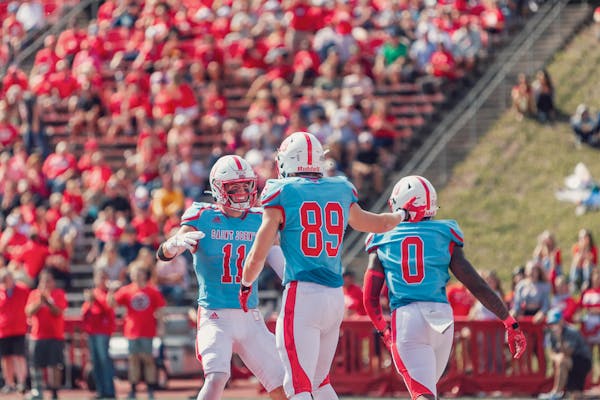For the first time in the history of the state, a school other than the University of Minnesota will host a Division I football game on Saturday as St. Thomas welcomes Butler to O'Shaughnessy Stadium in St. Paul for its first Pioneer League game.
The Tommies are 1-1 after shimmying out a 12-9 win in their opener at Division II Michigan Tech and getting a 44-3 reality check against Northern Iowa in Cedar Falls last weekend.
Coach Glenn Caruso, with his irrepressible attitude toward growth via learning, said simply of that loss: "Loved it."
But the contest against Butler also carries a different kind of importance. It's the first home game since the Tommies beat Bethel 17-7 on Nov. 16, 2019 — their final football game as an MIAC member and a Division III school. And the game will be an on-campus boost for a student body, faculty and administrative staff that is both anticipative and curious about what this D-I transition means for a university that is rapidly expanding its reach.
"I think this is as much of a football game as it is a campus celebration of being able to gather together," Athletic Director Phil Esten said.
Ticket sales were around 3,500 midweek with 1,500 student tickets sold — capacity at O'Shaughnessy is 5,000 — and several students on campus echoed an "Oh, of course" sentiment when asked if they'd be attending.
Freshmen Lily Vance, Dylan Ayres and Ryan Kovalik took a break from doing the thing only college students do — hitting a volleyball together at 12:30 p.m. on a Wednesday — and said they were going to the game. They also felt like the return of campus athletics meshed incredibly well with the energy from the recent return of students to in-person learning.
Seniors Kendall Ball and Makayla Henry were sitting outside the Anderson Student Center studying, and they noted that going Division I changes the image of the school, which left them a little envious.
"We're going to get all of these dope athletes," Ball said, "and we're leaving."
There is no question that for a school such as St. Thomas — a Catholic university with an undergraduate enrollment of 6,137 — taking a step into Division I athletics changes perceptions internally and externally. And the move comes after years of expansion projects on the St. Paul and Minneapolis campuses and "St. Thomas 2025," a five-year plan focused on education and demographics spearheaded by President Julie Sullivan.
“I'm not stupid. We have to get bigger, we have to get stronger, we have to get faster. But in terms of attitude, culture and toughness, we weren't outmanned in any way.”
University chaplain Lawrence Blake said there is a growing emphasis to increase inclusivity and visibility while staying true to foundational Catholic beliefs. He noted that campus ministry now includes Jewish, Muslim and Christian faith leaders and that the move to Division I — while not initially a voluntary decision — was born of a similar emphasis to expand the university's reach.
"I mean, I bet Dr. Sullivan probably gets an e-mail once a day saying, 'Well, St. Thomas is not what it used to be,'" Blake said. "And it isn't."
"Here again, the board, the key leaders in the athletic department and Dr. Sullivan said, 'This is an opportunity,'" he continued. "The opportunity now is to gain national recognition through the growth of our athletic program. That has happened."
While it is an opportunity, St. Thomas academic administrators noted that excitement over a change doesn't make it simple. Students are returning to in-person courses after a long time away. There is worry about the learning gap created by the pandemic, the stress on young people because of the racial awakening in Minnesota, COVID-19 and environmental concerns.
Now you add a large number of young student-athletes who have rapidly watched their sports world go from a hyper-localized Division III conference to a national Division I profile, which has created new challenges — coaches have left teams, new tutoring rules have to be implemented and travel demands are far more extensive. The work to help ease their transition is something that educators will take on as well.
This is a change for the university, but Saturday they will get to revel in the return of a piece of normalcy: A noon kickoff on campus.
And while Caruso said that normalcy is an evolving concept through two weeks, he has told his players that this season will have to be about staying present.
"It's just like every week there is something new coming at you. You play at 12, you play at 1, you play at 4, you drive eight hours on a bus to the middle of nowhere in Northern Michigan, you get on a plane and you go," Caruso said. "There's just so much that's different, we're just trying to stay in the moment."
That mind-set worked against Northern Iowa, where the team still found joy in being overmatched.
"They'd be coming off the field smiling," Caruso said. "There might be blood coming out of his arm, shoulder pad pulls outside, but our kids were absolutely loving the chance to just fight for each other and compete."
The campus attitude toward the team reflects what Caruso has seen from his players: A willingness to take on a new challenge.
"I get it. We have a long way to go," he said. "I totally understand. I'm not stupid. We have to get bigger, we have to get stronger, we have to get faster. But in terms of attitude, culture and toughness, we weren't outmanned in any way."





